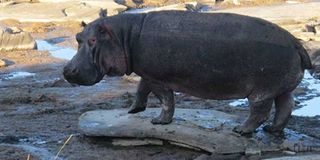Rivers in the Mara ecosystem drying up as rains fail

A hippo stands in the drying Talek River in the Mara. Water levels in five major rivers including the mighty Mara River have drastically reduced, threatening the entire Mara-Serengeti ecosystem. PHOTO | NATION MEDIA GROUP
What you need to know:
- The situation has contributed to increased cases of human-wildlife conflicts in the region.
- The rivers are source of livelihood for millions of people, livestock and wildlife, are at all-time low levels.
- The drought has pushed wildlife from their habitats into human settlements, increasing the risk of conflict.
Water levels in five major rivers including the mighty Mara River have drastically reduced, threatening the entire Mara-Serengeti ecosystem.
Conservationists have long argued that it is only a matter of time before rivers like the Mara dry up.
Mara, Talek, Enkare Narok, Siyiabei and Ewuaso Ngiro, which are the major rivers in Narok County and a source of livelihood for millions of people, livestock and wildlife, are at all-time low levels.
Siyiabei, Enkare Narok and Ewuaso Ngiro rivers pour their waters into Lake Magadi and Lake Natron in Tanzania, famous for flamingo breading.
Apart from being the spine of the Mara ecosystem, the Mara and Talek feed Lake Victoria and are the main contributors of water in the Nile basin that all the way to Egypt.
MAU FOREST
The Mara-Serengeti ecosystem coordinator Nick ole Murero said that the destruction of the Mau Forest over the years has been a major contributor to the river’s low water levels.
Mr Murero said that the situation has contributed to increased cases of human-wildlife conflicts in the region.
He said apart from delayed rains, destructive human activity in the Mau Forest has exacerbated the effects of drought as rivers keep drying up and the animal population diminishes.
“Water levels are low in all this rivers. Farming activities where water is being diverted to farms upstream for irrigation is also a challenge,” said Mr Kuyioni.
MAASAI MARA
Hoteliers and tour operators have severally warned that the world-famous Masai Mara Game Reserve may soon lose its gleam as drought threatens the wildlife that attracts thousands of tourists every year.
A spot check by the Nation last week revealed dozens of crocodiles and hippos fighting in the small pools of water in the drying Mara and Talek rivers which traverse the reserve.
The drought has pushed wildlife from their habitats into human settlements, increasing the risk of conflict.
“Hippo and elephant attacks are becoming rampant, as these animals move out of their habitats to human settlements around Talek, Sikinani, Siana, Oloolaimutia and Aitong to look for water,” said Peter Lemein, a wildlife researcher in the Mara.





